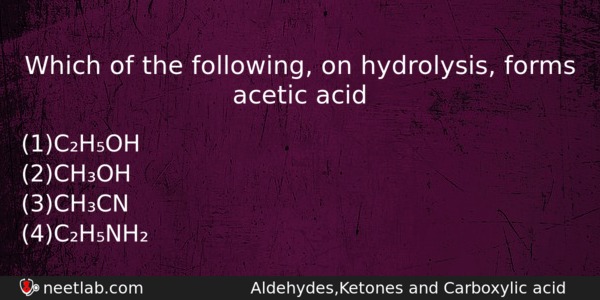| ⇦ | 
| ⇨ |
Which of the following, on hydrolysis, forms acetic acid
Options
(a) C₂H₅OH
(b) CH₃OH
(c) CH₃CN
(d) C₂H₅NH₂
Correct Answer:
CH₃CN
Explanation:
No explanation available. Be the first to write the explanation for this question by commenting below.
Related Questions: - Proteins gives purple colour when tested with
- What is the mole fraction of the solute in a 1.00 m aqueous solution?
- The solubility of anhydrous AlCl₃ and hydrous AlCl₃ in diethylether are S₁
- Reaction of phenol with chloroform in presence of dilute sodium hydroxide finally
- Which of the following pairs show reverse properties on moving along
Topics: Aldehydes Ketones and Carboxylic Acid
(89)
Subject: Chemistry
(2512)
Important MCQs Based on Medical Entrance Examinations To Improve Your NEET Score
- Proteins gives purple colour when tested with
- What is the mole fraction of the solute in a 1.00 m aqueous solution?
- The solubility of anhydrous AlCl₃ and hydrous AlCl₃ in diethylether are S₁
- Reaction of phenol with chloroform in presence of dilute sodium hydroxide finally
- Which of the following pairs show reverse properties on moving along
Topics: Aldehydes Ketones and Carboxylic Acid (89)
Subject: Chemistry (2512)
Important MCQs Based on Medical Entrance Examinations To Improve Your NEET Score
18000+ students are using NEETLab to improve their score. What about you?
Solve Previous Year MCQs, Mock Tests, Topicwise Practice Tests, Identify Weak Topics, Formula Flash cards and much more is available in NEETLab Android App to improve your NEET score.
Share this page with your friends

Leave a Reply